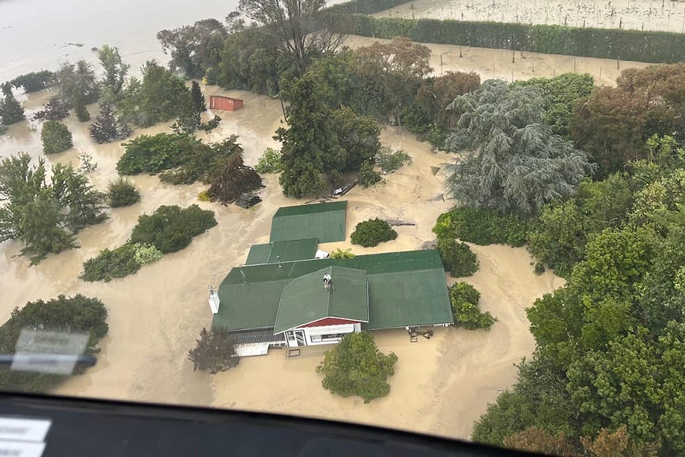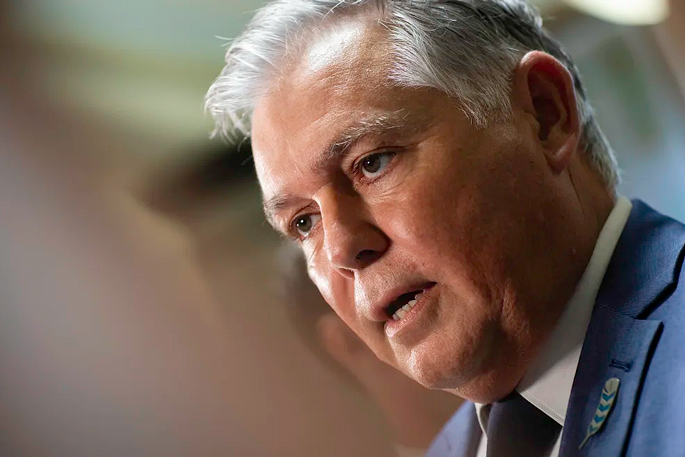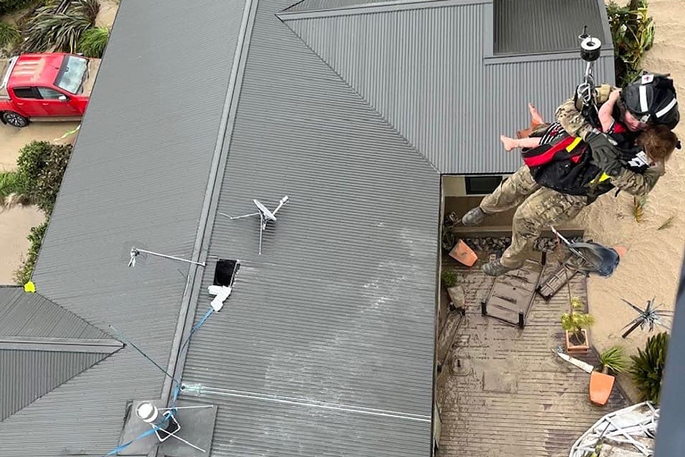Some "unsung heroes" pooled their skills to pluck people from rooftops and avert more tragedies after Cyclone Gabrielle hit, a helicopter pilot says.
Today marks a year since the full force of Cyclone Gabrielle hit much of the North Island, leaving a trail of devastation in its wake.
Eleven people were killed, homes and businesses were destroyed and power and communications networks were knocked out in huge parts of Hawke's Bay and Tai Rāwhiti.
In Hawke's Bay, it's estimated more than 400 people were lifted off roofs by helicopter crews in the hours after Cyclone Gabrielle tore though the region.
One of those pilots, Joe Faram, who owns Rotorforce Helicopters Hastings, said he had been sent up on a survey mission, however, it was soon obvious there was "a catastrophe unfolding" and evacuations would be needed.
"It unfolded underneath us and as the day grew so did some of the problems we were dealing with."
There were no communications, however, it became apparent when pilots reached Esk Valley and parts of the Puketapu area that many residents needed to be rescued.
"The people we were seeing were appearing on roofs of homes. I witnessed the water going through and halfway up doors and then, within 20 minutes, it was onto the rain gutter height."
People were clambering onto their roofs from the outside of their homes or even having to break through ceilings.
"So when we started evacuating those people we were dealing with some quite hysterical and emotional people and panicking people.
"So it all happened quite quickly."
 A person on the rooftop of an Esk Valley property. Photo: Supplied / NZDF.
A person on the rooftop of an Esk Valley property. Photo: Supplied / NZDF.He praised his crewman, Nathan Ferguson, who brought "instant calm" as he leapt down onto each roof to help the evacuees, some of whom brought cats and dogs with them.
"There was shock and disbelief by those occupants that were evacuating and I think relief they were getting out of their site but at the same time they were dealing with a lot of emotions, losing everything, their pride and joy."
He was shocked at what he he was seeing, he told Morning Report.
"With the low visibility and the amount of flooding you're second guessing that you were where you thought or you knew you should have been, 'cos all your landmarks were under water and the place was certainly a different picture to what you normally saw outside the helicopter window."
He's unsure how many they rescued.
"You're too busy, it was too intense to be bothering about counting numbers but there was a lot of people."
Faram says there were a lot of "unsung heroes" who used their initiative and coordination skills on that day. People worked together and used local knowledge to avert many tragedies.
He says he had talked to Civil Defence as well as councils and mayors since the event and it has been acknowledged that a range of local resources can be pulled together in times of emergencies.
"It's that situational awareness and at that time it's easy to point the finger of what we could have done better but I think we certainly have the lessons to cope going forward."
A year on from the devastation of Cyclone Gabrielle, authorities are more prepared for future natural disasters, Mark Mitchell says.
Hard lessons have been learned - Minister
 Photo: RNZ / Angus Dreaver.
Photo: RNZ / Angus Dreaver.A year on from the devastation of Cyclone Gabrielle, authorities are more prepared for future natural disasters, the Emergency Management and Recovery Minister Mark Mitchell says.
For the communications network which saw cellphone connectivity and landlines fail during Gabrielle, Mitchell says there has been a lot of work done locally on strengthening it and making it more resilient.
However, in a severe event, communications could still be disrupted so it was advisable people were prepared with the likes of a grab bag.
Mitchell was asked about RNZ's report on failings in the 111 emergency call system which is so old, slow and fragmented that it is causing deaths and injuries, police documents show.
Mitchell who is also Police Minister has received advice on updating the 111 system but will not commit to making changes before the next election.
He's working with police on how the system could integrate receiving text messages, however, it's part of ongoing work on cost savings and sorting out budgets, he says, however, the country needs a world class emergency call system.
"We're sitting down now and I'm working with police in terms of what we do about it."
He says there has been massive damage to roading and water infrastructure in Hawke's Bay and Tai Rāwhiti and that took time to rebuild.
The two regions worst affected would now be better placed to respond to weather disasters because of what they had been through, he believes.
An example of improvements included a new purpose built command and control centre for emergency services and first responders that has been built for Tai Rāwhiti which he visited before Christmas.
"The planning that has gone into it, the learnings that have come out of Gabrielle and Hale mean that we are in a better stronger position."
He says New Zealand is prone to natural disasters so it is essential to have "a high state of readiness".
Sir Jerry Mateparae's report on improvements to Civil Defence which is due to be published in March will contain recommendations for also putting the country on a better footing to respond to disasters.
Mitchell says he sympathises with those who have been deeply affected by the cyclone, especially those living in Hawke's Bay and Tai Rāwhiti.
"There's extraordinary stories of how the community came together and supported one another through it but it's extremely difficult and there's definitely fatigue out there and from a central government point of view we are completely focused on trying to speed things up and trying to get closure for people so they can get on with their lives."
'We're surrounded by water in Hawke's Bay'
Whirinaki resident Todd Smith, who received an award for his rescue efforts during the cyclone, isn't happy with the way Hawke's Bay is being rebuilt in the same way as pre-cyclone.
"There are still a heck of a lot of lessons to be learned right across the board. We're surrounded by water in Hawke's Bay, Hawke's Bay is built on a flood plain.
"They've just put everything back to the way it was which I don't think is adequate. A lot of things needs to be upgraded."
In Whirinaki, on the coast near the Esk River mouth, the floodwater rose rapidly.
Smith went door to door helping rescue his neighbours and get them to safety.
He told Morning Report residents began to realise how isolated they were with the bridges swept away and they were unsure how soon emergency services might reach them.
Water had started rising in his house before 4am and once his family was safely evacuated he went to help those nearby.
The water was still rising, people were distressed and there were traumatised children in floodwaters.
"It was just something else ...something like out of a movie."
The community had been told the previous day they would receive an evacuation order around 10pm if the river reached a certain level.
"That never happened until about 5 to 6am in the morning once people would have been about chest height [in the water] in our street and once lives were already lost."
Smith said the biggest lesson he had learned was not to wait around for any advice from authorities and instead he would rely on his "gut reaction".
Preparing 'to look after ourselves in our own backyard'
In Te Tai Rāwhiti the Tolaga Bay health centre, Te Whare Hauora o Te Aitanga a Hauiti, has helped about 800 people in the past year.
Chief executive Rina Kerekere says she wants to acknowledge and send aroha to whānau of those who died in the tragedy as well as those who were still navigating through the uncertainty the event had caused.
"Not a lot has changed, whānau are still struggling, experiencing the trauma. It's still hard to work through where they're going, what's going to happen, especially in regard to the transition of all the categorisations of their whenua and their whare."
There are still at least eight whānau on the list needing permanent housing although they had the use of emergency housing pods.
An enormous amount of planning and other work had been done on making their isolated community self-sufficient and able to cope in times of emergencies, says Kerekere.
During Cyclone Gabrielle there had been no communications for a week.
"While we have a lot of hope we do need to prepare ourselves. Our strategy is that we are our own solution."
Kerekere says they have been working with other organisations such as the Red Cross and the volunteer fire brigade to ensure they were well trained "to look after ourselves in our own backyard".



0 comments
Leave a Comment
You must be logged in to make a comment.